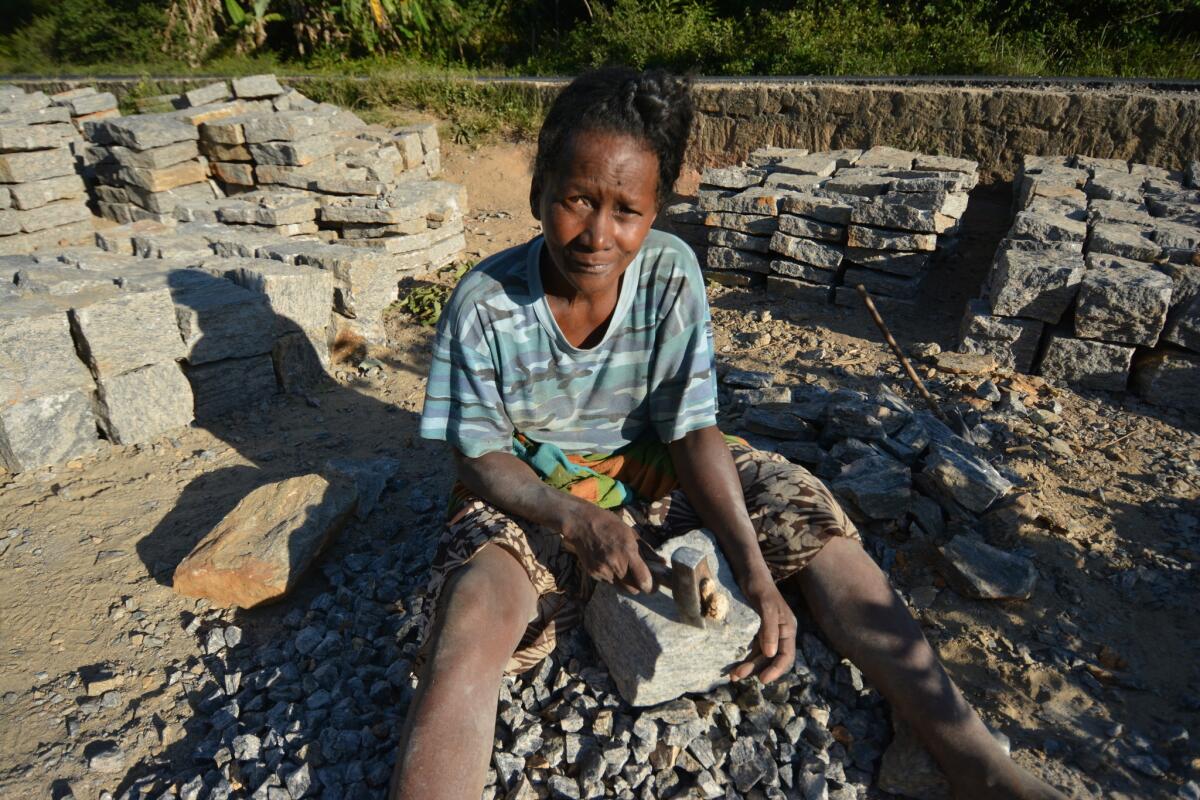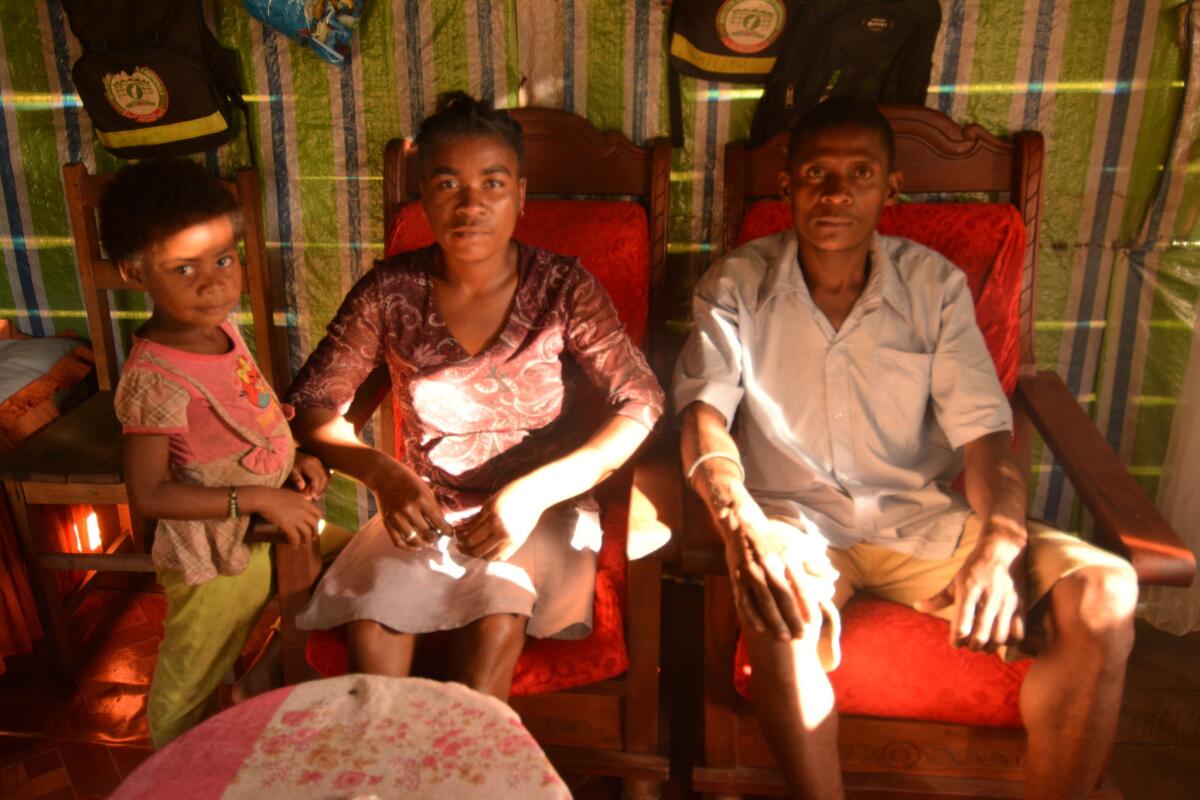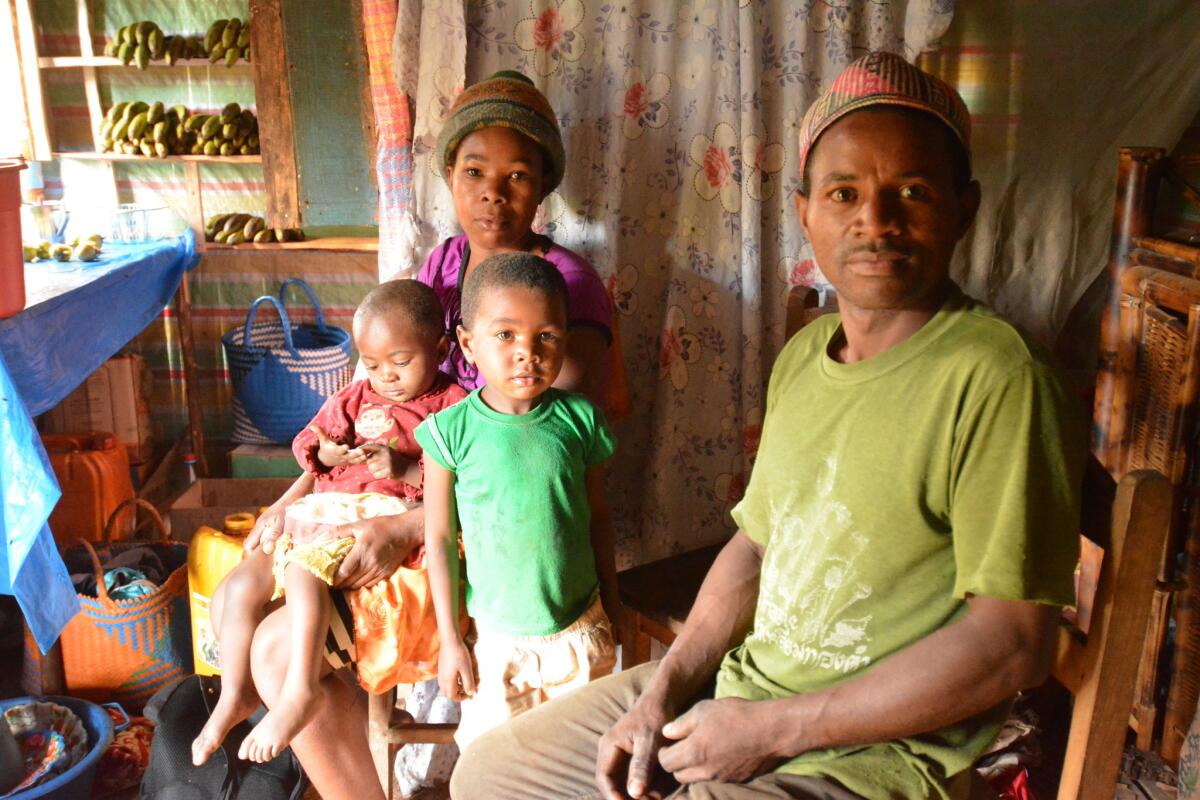Madagascar’s lemurs lurch toward extinction, but there could be a way to save them

Madagascar faces a cycle of crushing poverty. (June 7, 2017)
- Share via
Reporting from Anevoka, Madagascar — The road to Maromizaha Forest in Madagascar winds through hills dotted with charred stumps resembling broken teeth.
Trucks roar past a woman named Madeleine, who sits by the road chipping away at granite slabs, making gravel.
The hills above were once covered in trees, teeming with shrieking lemurs. But the forest is dying.
It is being destroyed by desperately poor families who survive by selling firewood or charcoal, and by well-connected crime syndicates who get rich on illegal mining and logging.
Madagascar has committed to the U.N.’s ambitious Sustainable Development Goals to combat corruption, protect forests and biodiversity, and eliminate poverty by 2030. But its failure to stem corruption only fuels deforestation.
More than a year ago the government declared the Maromizaha Forest a national park, banning charcoal burning, farming, logging and mining. That changed everything for people living in a dozen nearby villages. Until then, each farmer would burn new forest every year to plant crops, in a slash-and-burn method known here as tavy.
We have a saying here: ‘An empty stomach has no ears.’ If people can’t eat, how can you save the lemurs?
— Jonah Ratsimbazafy, a Madagascan lemur expert, head of local lemur research organization, GERP
“The more protected the forest is, the harder life has become,” says Madeleine, 59, who like many here has one name. “We can’t do charcoal any more. We have been doing slash and burn farming for generations, but since they protected the forest, there’s nothing for us to do.”
She breaks rocks to survive. Her hammer rings out like a steely woodpecker and shards of stone fly. There is blood on her finger where she hit herself.

Telolahy Lesabotsy, 36, a farmer with five children, feels impotent and furious. Last year, he thought he could get away with chopping down a tree and burning charcoal a few yards inside the national park. He was arrested, faced a village tribunal and was warned never to do it again.
“I am really struggling now. I’m even afraid that my children will have to beg on the road. They have never been to school. I have no money for meat. I am really, really poor.”
::
Lemurs, found only in Madagascar, are the most threatened mammal group on Earth, according to a 2014 paper by the International Union for the Conservation of Nature.
Madagascar has more than 110 species of lemurs, some which grow to 3 feet in height, others as small as a mouse, 90% of them facing extinction because of deforestation.
An island off East Africa the size of Texas, Madagascar has lost 80% of its forest, half of that since the 1950s, according to Washington-based Environmental Investigation Agency, a nongovernment group that investigates environmental crimes.
“We have a saying here: ‘An empty stomach has no ears.’ If people can’t eat, how can you save the lemurs?” said Jonah Ratsimbazafy, who heads the local Group for Study and Research on Primates of Madagascar, known as GERP.
“If you ask people to be part of your conservation effort and they’re dying, forget it,” he said. “When people have got little access to food, education and health, conservation is not easy.”
It is, however, easy for crime networks to bribe poorly paid forest rangers and law enforcement officials, Ratsimbazafy said.
At least a million logs in protected forests were felled illegally between March 2010 and March 2015, mostly endangered rosewood trees, dragged along slippery forest paths, stacked on beaches and smuggled by night onto boats headed for China and other Asian countries, according to a February report by Traffic, a conservation group.
The report exposed rampant bribe-taking, government corruption and “effective zero control” of forests because judges fail to penalize offenders.
The country lost 2.47 million acres of forest between 2005 and 2013, Traffic reported, with deforestation roaring along at 1.5% a year from 2010.

On the rural roads in the south, people trudge into the forest with small sharp axes and return bearing tree branches on their heads. In the north, thousands of illegal miners invade the protected forests, uprooting or felling trees and killing lemurs as food.
More than 45,000 illegal miners poured into the protected Didy forest in central Madagascar last year, pulling down trees and digging up gravel in search of sapphires. Such mass invasions are common.
Complicating the problem is Madagascar’s changing climate. The more the population consumes the forests, the drier the country becomes and the more frequent are the droughts that lock people into poverty.
Last year, the government asked GERP to manage the Maromizaha Forest. The organization trains villagers as forest patrollers and teaches farmers how to avoid slash-and-burn cropping. It helps people find new livelihoods including fish farming, beekeeping, working in hotels and restaurants and acting as guides or porters for lemur researchers and tourists.
But some villagers are unconvinced.
“Some people shout at us and some even threaten us,” said Joseph Marson, 46, a member of the unarmed forest patrol team. In August, two farmers illegally clearing the forest threatened to attack him and other patrollers with machetes.
“They said, ‘We’ll kill you and none of you will leave the forest alive.’”

In his small room, Filgence Rakotoarimanana’s pillow lies yards away from the trucks that grind by day and night. With his wife, Soahamarina, and six children, he farms at the edge of the forest, planting beans, potatoes and cassava to sell.
His youngest girl, Hantarianina, 18 months old, squalls and plunges her fingers into a pot with the dregs of some cold boiled cornmeal. A gray parrot, captured from the forest, hops around the room, pecking at specks of grain.
“We are angry,” Soahamarina says. “We used to do charcoal. That was our main livelihood. Since they told us to protect the forest, we get no benefit from it.
“We’re poorer. We don’t have money. We don’t even have enough to feed our children.”
But the GERP project is gaining supporters.
Local farmer Razafimahatratra joined the forest patrollers last year, fearing that “even our generation won’t see trees anymore” if the destruction continues.
“The animals are disappearing. We used to see them at the side of the road. Now, you have to go deep into the forest to find them,” Razafimahatratra said.
“Most people don’t care about the animals. They’re just worried about putting food on the table.”
Since the patrols started around Maromizaha, fewer cases of charcoal burning and illegal logging have been found. But last September, the patrollers collided with one of the country’s most powerful men, who calls himself “the little brother of the sun” — the younger brother of the president.
Razafimahatratra, 63, and the other patrollers found six illegal tourmaline miners and a 30-foot mine in the forest. They arrested the miners with the help of the regional environmental authority and police.
The miners boasted that they were working for a powerful man. They phoned the president’s brother, Aina Rakotoarimanana.
The president’s brother demanded — by phone and later in person — that authorities free the miners and drop charges, according to the patrollers and an environmental authority official. He sent a chill through the office when he visited the environmental authority, the official said, speaking on condition of anonymity for fear of dismissal.
A judge dismissed a similar case last year involving one of the same miners.
The patrollers fear violence for confronting such a powerful man. They worry about wearing their uniforms. They spook at every large SUV that glides down the road.
“We’re afraid this person might kill us,” Razafimahatratra said.
GERP director Ratsimbazafy has some powerful enemies, but he will not give up on his lifelong struggle to save lemurs. His organization has discovered several new species of lemurs in recent years. And in February, American primatologist Cynthia L. Frasier discovered a new species of dwarf lemur, weighing just a few ounces, in the northern forests.
But sometimes, the joy of a discovery turns to ashes.
“In the north, we discovered a new species of lemur in 2008,” Ratsimbazafy said. “Two years later, that area was a cassava field.”
Twitter: @RobynDixon_LAT
This story was reported with a grant from the United Nations Foundation.
More to Read
Sign up for Essential California
The most important California stories and recommendations in your inbox every morning.
You may occasionally receive promotional content from the Los Angeles Times.










